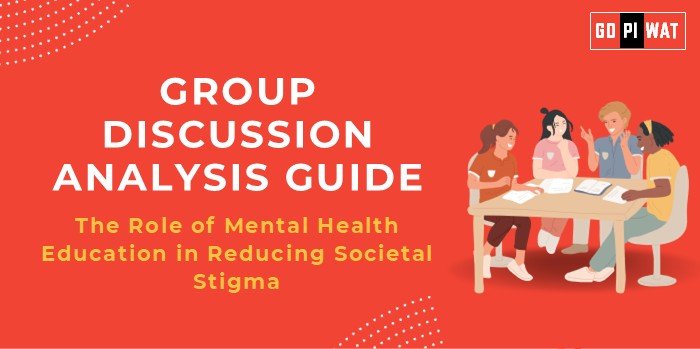📋 Group Discussion (GD) Analysis Guide: The Role of Mental Health Education in Reducing Societal Stigma
🌐 Introduction to the Topic
Mental health education has gained significant attention globally as a tool to combat the deep-rooted stigma associated with mental illnesses. In societies where misconceptions and taboos prevail, structured education on mental health plays a pivotal role in fostering empathy, reducing discrimination, and promoting early intervention. As B-school students aiming for leadership, understanding this topic is vital in shaping inclusive policies and initiatives.
📊 Quick Facts and Key Statistics
- 🧠 Global Burden of Mental Disorders: 1 in 8 people worldwide live with a mental health condition (WHO, 2023).
- 💰 Economic Impact: Mental health issues cost the global economy $1 trillion annually in lost productivity (World Bank, 2023).
- 👶 Youth Mental Health: 15% of youth aged 10-19 experience a mental health disorder, yet 70% do not receive care (UNICEF, 2023).
- 🇮🇳 India’s Efforts: The National Mental Health Programme (NMHP) has been operational since 1982, aiming to integrate mental health into primary healthcare.
🤝 Stakeholders and Their Roles
- Government: Develops mental health policies, allocates resources, and integrates mental health education into national curriculums.
- Educational Institutions: Provide platforms for awareness, training, and destigmatization programs.
- Healthcare Providers: Advocate for mental health literacy, early interventions, and community outreach.
- NGOs and Advocacy Groups: Campaign against stigma, organize workshops, and ensure inclusivity.
- Corporate Sector: Implements employee mental health programs and invests in awareness campaigns.
🏆 Achievements and Challenges
✅ Achievements:
- Global Progress: WHO’s “Mental Health Action Plan 2013–2030” has driven multi-nation collaborations.
- Policy Reforms: The Indian Mental Healthcare Act (2017) decriminalized suicide and emphasized the right to care.
- Awareness Campaigns: Initiatives like “It’s Okay to Not Be Okay” have normalized conversations about mental health.
⚠️ Challenges:
- Cultural Barriers: Persistent taboos and misinformation about mental health.
- Resource Gaps: Only 0.05 psychiatrists per 100,000 population in India compared to WHO’s recommended 3 per 100,000.
- Funding: Mental health receives less than 2% of total health budgets globally.
🌍 Global Comparisons:
- Success: Canada’s “Let’s Talk” campaign significantly reduced stigma through sustained dialogue.
- Challenge: In low-income countries, 75% of people with mental disorders receive no treatment.
📖 Case Studies:
- India: Tamil Nadu’s “Manasa” program integrates mental health in schools, benefiting 1,000+ students annually.
- Global: The UK’s Time to Change initiative reduced mental health stigma among 5 million individuals through public engagement.
💬 Structured Arguments for Discussion
- Supporting Stance: “Mental health education empowers individuals with knowledge, encouraging compassion and reducing stigma.”
- Opposing Stance: “Without addressing systemic healthcare gaps, mental health education alone cannot combat stigma effectively.”
- Balanced Perspective: “While mental health education is essential for reducing stigma, structural reforms and accessible care are equally critical.”
✨ Effective Discussion Approaches
- Opening Approaches:
- 📈 Statistical Impact: “1 in 8 people globally face mental health issues; addressing stigma through education can transform lives.”
- 📖 Case Study Opening: “Tamil Nadu’s success in school mental health programs illustrates the power of early education.”
- 🔄 Contrast: “Despite awareness campaigns, over 70% of youth globally lack access to mental health care.”
- Counter-Argument Handling:
- Use data to counter misinformation, e.g., mental health treatment improves productivity by 12% annually (WHO).
- Highlight case studies to showcase education’s effectiveness.
📊 Strategic Analysis of Strengths and Weaknesses
- Strengths: Growing global recognition and support, integration of mental health into education policies.
- Weaknesses: Limited trained educators and professionals, persistent social and cultural stigma.
- Opportunities: Leverage technology for wider awareness campaigns, collaborations between public and private sectors.
- Threats: Misinformation spread through social media, underfunding of mental health programs.
🏫 Connecting with B-School Applications
- Real-World Applications: Policy planning for inclusive corporate environments, developing CSR initiatives focused on mental health awareness.
- Sample Interview Questions:
- “How can mental health education shape corporate leadership?”
- “Discuss the challenges in implementing mental health policies globally.”
- Insights for B-School Students: Explore mental health’s impact on workplace productivity, advocate for inclusive leadership practices.


